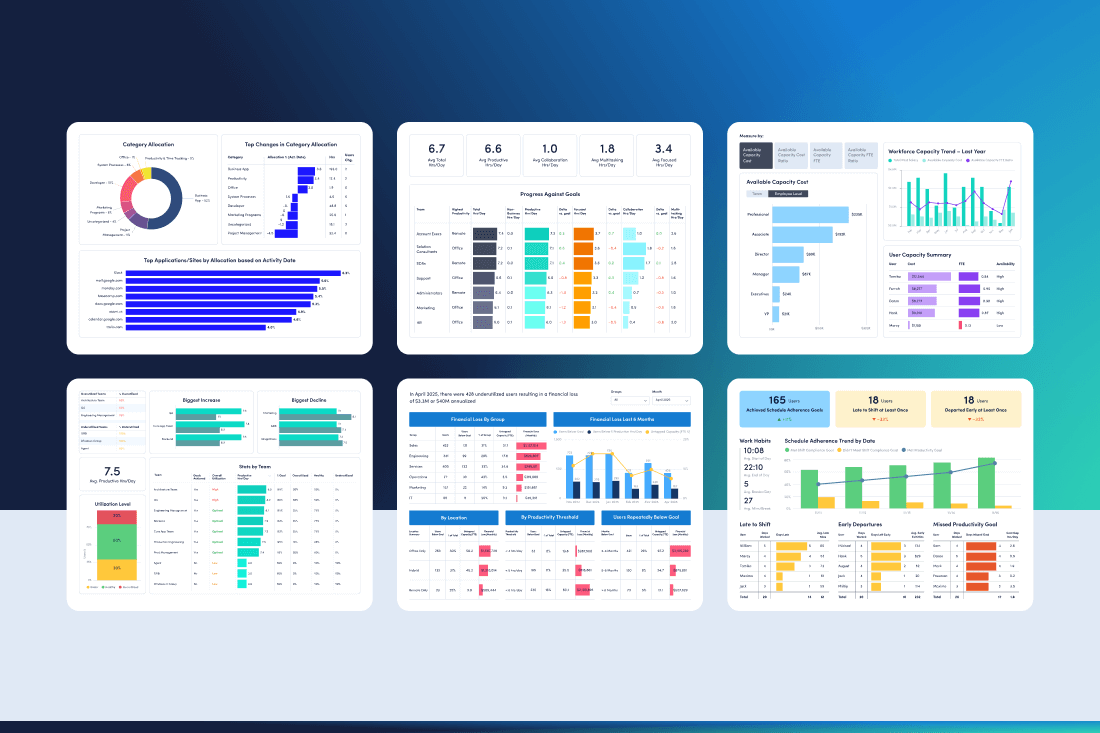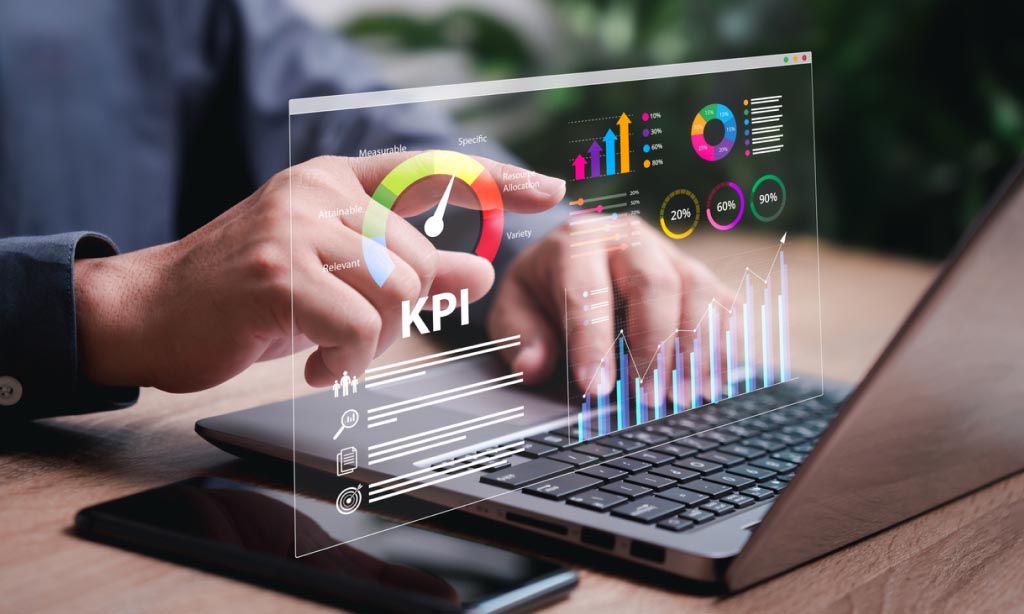Employee monitoring offers unprecedented opportunities to improve productivity, encourage healthy work habits and help people perform their best. But have some organizations gone too far, too fast?
Before you track employee activity, it’s important to understand the do’s and don’ts of monitoring. To help, let’s examine the latest research to see what works — and what doesn’t.
If you want to ensure you’re monitoring employees the right way, for the right reasons, this article is for you.
At a glance: The 7 most critical employee monitoring statistics
The employee monitoring software market is growing fast, and dozens of studies evaluate their impact and effectiveness. Here are a few of the most important highlights you need to know for 2024:
- 80% of in-office companies track attendance, but experts worry this strategy could backfire (Resume Builder)
- 37% of remote companies use video surveillance to watch employees 4+ hours a day (Resume Builder)
- More than 40% of employees know they’re being monitored — and many don’t like it (Forbes)
- 73% of managers store messages, emails and calls to evaluate performance (CNBC)
- Only 30% of executives are confident their organizations use employee data responsibly (Accenture)
- More than half of monitored employees feel tense or stressed out at work (AMA)
- 68% of managers are convinced monitoring improves performance, but most employees disagree (HR Dive)
What the top employee monitoring statistics mean for your business
What do the numbers mean for your business, and how should you use them to guide your own employee monitoring strategy? Let’s examine each of the above findings in more detail.
Stat #1: 80% of companies track office attendance
As companies weigh return-to-office mandates against hybrid work, many business leaders are concerned about compliance. And they’re monitoring employees to track attendance. Eight in ten companies track attendance by badge swipes or other means, and 95% say employees will suffer consequences — some of them severe — if they don’t comply.
These organizations threaten to reduce pay, cut bonuses and benefits or even fire employees based on workplace monitoring data. But experts say this approach may backfire when overly rigid policies cause people to leave. In addition, research shows relying on badge data provides an incomplete picture on office occupancy and misses as much as 20% of workers who are actually in the office.
Stat #2: 37% of remote companies use video surveillance
Meanwhile, companies with remote workers are taking a different approach to employee monitoring. The vast majority of remote companies use some form of employee monitoring — no surprise there. But 37% also require employees to stay on live, monitored video feeds. Within this group, a surprisingly high percentage say they require remote employees to be on camera all day — and 93% monitor live video feeds for four or more hours.
If this sounds enticing, take note: While 97% of remote employers believe employee monitoring software has increased productivity, many employees disagree. More than two-thirds of surveyed companies say they’ve lost employees who didn’t want to be monitored.
Stat #3: More than 40% of employees know they’re being monitored — and many don’t like it
Four in ten workers say employers keep tabs on their online activities during work hours, and it’s causing unease. While 31% of workers say it positively impacts job satisfaction, nearly half feel stress and anxiety instead. In addition, 43% say it negatively affects company morale and 39% say it’s harmed the employee-employer relationship. Perhaps even more troubling is the two-thirds of employees who haven’t received formal monitoring guidelines or policies.
These stats highlight the importance of trust and transparency between employers and employees. It’s not enough to tell employees you’re using monitoring software. Honor employees’ privacy by letting them access their own data to self-manage and make adjustments without outside intervention.
Stat #4: 73% of managers store messages, emails and calls to evaluate performance
Demand for employee monitoring software has skyrocketed since the COVID-19 pandemic. But is it for the wrong reasons? For some organizations, the new work-from-home standard fuels productivity paranoia. In response, 73% of managers are storing recordings of staff calls, emails or messages to evaluate their employees’ performance.
Rather than supporting employees with workload management and productivity dashboards, these managers look at data through the lens of surveillance and micromanagement. One study found this approach encourages people to work at a slower pace just to fill the time. Which is a shame, since so many employee monitoring tools are designed to help create company cultures where productivity thrives.
Stat #5: Only 30% of executives are confident their organizations use employee data responsibly
While 62% of surveyed executives say their organizations use technology to collect people data, less than one-third are confident they’re using the data responsibly. Meanwhile, 64% of employees say recent scandals over data misuse make them concerned their employee information might also be at risk.
However, there is good news. More than 90% of workers are open to on-the-job data collection to improve performance and wellbeing. In fact, more than 60% would exchange their work-related data for more customized rewards, benefits and learning and development opportunities.
Stat #6: More than half of monitored employees feel tense or stressed out at work
According to the American Psychological Association, 56% of monitored workers feel tense or stressed out at work — compared with 40% of those who are not monitored. However, it’s not the monitoring itself that’s the problem. The reason companies monitor is what matters.
Research shows micromanagement-style monitoring is extremely stressful, limits autonomy and fosters job insecurity. As a result, the very tools intended to fuel productivity end up creating a burned out, disengaged workforce. This happens when companies focus on constant monitoring instead of tracking what’s really important — all the ways employees contribute to organizational success, and what more they need to feel supported.
Stat 7: 68% of managers are convinced monitoring improves performance, but most employees disagree
Seven in ten managers believe employee monitoring technology improves performance. In stark contrast, 72% of their employees claim it has no impact on performance and in some instances actually diminishes it. Again, this is because many leaders still view employee monitoring from a workplace surveillance standpoint. The faster you identify employees who don’t meet expectations, the sooner you’ll resolve problems — or so the theory goes.
But what if high performers suddenly start missing deadlines and calling in sick? Does your software simply highlight a performance issue? Or will it tell you how and why your people are overworked, burned out and in desperate need of support so you can provide what they need to be productive again? If your currently technology fails in this area, it’s time to find an employee monitoring solution that actually helps increase productivity.
A few more employee monitoring statistics to consider
If you’ve fallen prey to any of the misjudgments mentioned above, you’re far from alone. Employee monitoring technology is still relatively new and many businesses are still learning how to use it. But demand is growing fast, which means it’s time to focus on using employee data responsibly and effectively. To see what we mean, consider these telling stats:
- Only 9% of surveyed IT pros say their organization doesn’t monitor employees at all. (Spiceworks)
- Global demand for employee monitoring software increased by 75% in Jan 2022, the biggest jump since an initial spike in 2019. (Top10VPN)
- The employee monitoring market is expected to reach $6.9 billion by 2030. (Market Research Future)
Just because other companies use employee monitoring software to conduct surveillance, that doesn’t mean you should follow their example. These statistics reveal how damaging that approach can be:
- 32% of employees who are monitored during work hours report their mental health as poor or fair. (AMA)
- 46% of tech workers say they’d quit their jobs if their organizations started tracking keystrokes or taking screenshots of their computers, and more than half would quit if the company uses facial recognition to monitor employee productivity. (Morning Consult)
However, there are bright spots — especially as more organizations use employee monitoring software to improve employee engagement and wellbeing. For example:
- 87% of workers say it’s appropriate for companies to monitor employees’ behavior at the office, and 62% say it’s OK for them to use monitoring technology. (SurveyMonkey)
- In Canada, 34% of employees say monitoring allows employers to help them work more efficiently, and 38% say it helps ensure staff are never underpaid. (Capterra)
- 68% of employees say it’s likely their current employers routinely monitor them and 80% say they trust their employer to do so appropriately. (SurveyMonkey)
Get employee monitoring right with ActivTrak
The secret to successful employee monitoring is understanding that surveillance is not the point. The real benefit is all the workforce insights you gain. That’s why ActivTrak’s employee monitoring software is designed with productivity in mind — so you have the data you need to help employees do their best work.
Are some teams overloaded but afraid to speak up? Our workload management dashboards tell you when it’s time to redistribute tasks. Wondering if your workforce would benefit from a 4-day workweek? Use ActivTrak to test it. Companies use our dashboards to speed up workflows, improve employee wellbeing and optimize technology investments. From location insights to capacity and headcount planning, it’s everything you need to to monitor employees the right way — for the right reasons.
Request a demo to learn why 9,500+ customers choose ActivTrak to measure and improve employee productivity.





